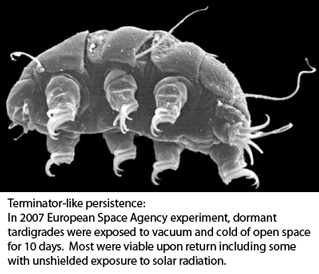 Tardigrades, commonly called water bears, are tiny (0.1-1.5 mm) water-dwelling invertebrates found in diverse environments. About 1000 species are known. Morphologic identification is difficult and may be limited to certain life stages–some species can be identified only from eggs, for example. Tardigrades can transform into a dormant state with remarkable ability to withstand extreme drying, cold, and radiation for prolonged periods, making them of interest for persons studying biology of tissue repair, aging and other fields.
Tardigrades, commonly called water bears, are tiny (0.1-1.5 mm) water-dwelling invertebrates found in diverse environments. About 1000 species are known. Morphologic identification is difficult and may be limited to certain life stages–some species can be identified only from eggs, for example. Tardigrades can transform into a dormant state with remarkable ability to withstand extreme drying, cold, and radiation for prolonged periods, making them of interest for persons studying biology of tissue repair, aging and other fields.
Tardigrade Barcoding Project has just launched their website at www.tardigradebarcoding.org. The project will “provide a set of indispensible tools for the identification of marine, freshwater, and terrestrial tardigrade species, and will greatly aid taxonomists and ecologists. It will also enhance understanding on the evolution, ecology, life-history and extraordinary tolerance of physical extremes for these animals.” I add that COI barcodes are likely to reveal great genetic diversity hidden within morphologically defined species (eg Blaxter et al 2003).
I look forward to learning more about tardigrades!
I think these tardigrades might be able to help with understanding of extrodinary tolerance fo physical extremes but thats about it. I need more proof, I dont believe these water bears can give understanding to evolution.
Hi
When barcoding tardigrades, how many specimens do you need of each species in order to get the right mass for the kit? Is 20-30 specimens enough, or do you need like 100 or more? Say a specimen which is about 2-300 mikrometer long.
Kind regards, Halldis Ringvold